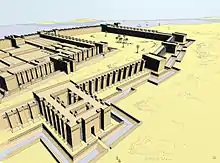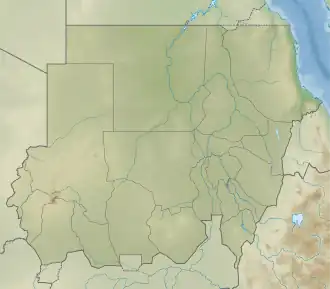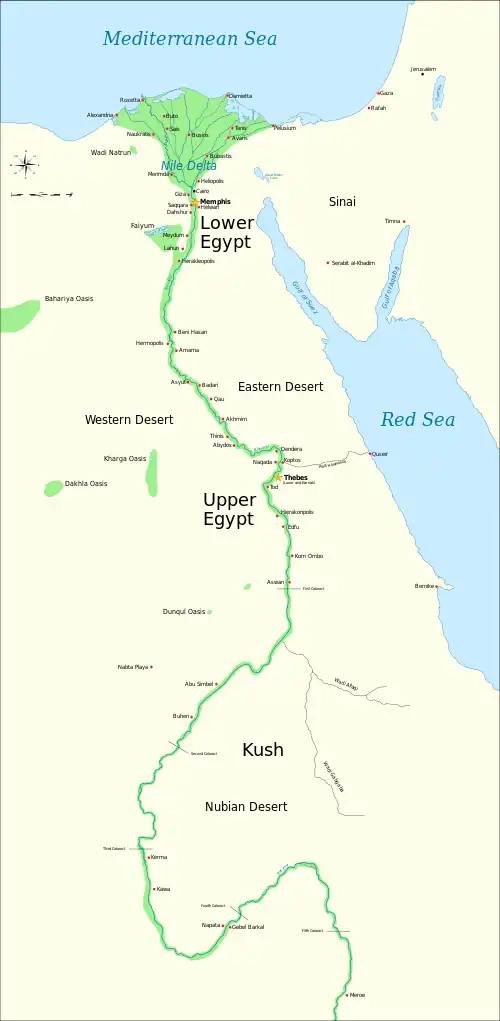 Fortress of Buhen, of the Middle Kingdom, reconstructed under the New Kingdom (about 1200 B.C.) | |
 Shown within Northeast Africa  Buhen (Sudan) | |
| Location | Northern, Sudan |
|---|---|
| Region | Old Kingdom |
| Coordinates | 21°55′N 31°17′E / 21.917°N 31.283°E |
| Type | Settlement |
Buhen (Ancient Greek: Βοὥν Bohón)[1] was an ancient Egyptian settlement situated on the West bank of the Nile below (to the North of) the Second Cataract in what is now Northern State, Sudan. Buhen, as a settlement was established during the Old Kingdom (2686–2181 BCE), but the fortress which Buhen is famous for was not established until the Middle Kingdom (2055–1650 BCE). During the Old Kingdom, Buhen was primarily used to smelt copper, until the Middle Kingdom, when the site was used by Egyptians to maintain the new southern border of Egypt.
It is now submerged in Lake Nasser, Sudan; as a result of the International Campaign to Save the Monuments of Nubia, many of its antiquities were moved to the National Museum of Sudan in Khartoum. On the East bank, across the river, there was another ancient settlement, where the town of Wadi Halfa now stands. The earliest mention of Buhen comes from stelae dating to the reign of Senusret I.[2] Buhen is also the earliest known Egyptian settlement in the land of Nubia.[3]
History of Buhen
| b(w)hn[4][1] in hieroglyphs | ||||||||
|---|---|---|---|---|---|---|---|---|
| Era: Middle Kingdom (2055–1650 BC) | ||||||||
In the Old Kingdom (about 2686–2181 BCE), there was an Egyptian colonial town at Buhen, that was also used for copper working. An archaeological investigation in 1962 revealed what was described as an ancient copper factory.[3] This was surrounded by a massive though crude stone wall. And further evidence point to the colony having been supplied from the north.[5] The settlement may have been established during the reign of Sneferu, of the 4th Dynasty. Nevertheless, there is evidence of earlier, 2nd Dynasty, occupation at Buhen.[5][6]
| bwhn[4][1] in hieroglyphs | ||||
|---|---|---|---|---|
| Era: New Kingdom (1550–1069 BC) | ||||
Graffiti and other inscribed items from the site show that the Egyptians stayed about 200 years, until late in the 5th Dynasty, when they were probably forced out by immigration from the south.
In the Middle Kingdom (2055-1650 BCE), the fortress at Buhen was established. The physical geography of Buhen worked in the benefit of the fortress. The large rock wall provided a strong preliminary base for the construction of the fortress. During the Middle Kingdom, the majority of people occupying Buhen were Egyptians who were directed South from Lower Egypt, and cycled through.[7]

Following the Middle Kingdom, came the Second-Intermediate Period. With the Second-Intermediate Period came the Funerary Stele of Sebek-dedu and Sebek-em-heb. The excavation of the stele produced a new understanding of the annexation of Nubia at the site of Buhen. The stele iterates that the Egyptians that had gained control over Buhen had been dependent on Nubian kings in achieving this.[8]
Fortress
Buhen is known for its large fortress, probably constructed during the rule of Senusret III in around 1860 BCE (12th Dynasty).[9] Senusret III conducted four campaigns into Kush and established a line of forts within signaling distance of one another; Buhen was the northernmost of these. The other forts along the banks were Mirgissa, Shalfak, Uronarti, Askut, Dabenarti, Semna, and Kumma. The Kushites captured Buhen during the 13th Dynasty, and held it until Ahmose I recaptured it at the beginning of the 18th Dynasty. It was stormed and recaptured by indigenous forces at the end of Egypt's 20th Dynasty.
One of the contributing factors for the creation of the fortress in Buhen was the goal of annexing Nubia. Both Senusret I and Senusret III dedicated much of their reign to campaigning into Nubia, in an attempt to extend the boundaries of Egypt. In doing so, the two kings built the fortress in Buhen, along with the other fortresses around the 2nd cataract. These fortresses established a new border for Upper Egypt.[10]
The fortress itself extended more than 150 metres (490 ft) along the west bank of the Nile. It covered 13,000 square metres (140,000 sq ft), and had within its wall a small town laid out in a grid system. At its peak it probably had a population of around 3,500 people. The fortress also included the administration for the whole fortified region of the Second Cataract. Its fortifications included a moat three meters deep, drawbridges, bastions, buttresses, ramparts, battlements, loopholes, and a catapult. The outer wall included an area between the two walls pierced with a double row of arrow loops, allowing both standing and kneeling archers to fire at the same time.[9] The walls of the fort were about 5 metres (16 ft) thick and 10 metres (33 ft) high.[9] The walls of Buhen were crafted with rough stone.[11] The walls of Buhen are unique as most Egyptian fortress walls were constructed with timber and mud-brick.[11] The fortress at Buhen is now submerged under Lake Nasser as a result of the construction of the Aswan Dam in 1964. Before the site was covered with water, it was excavated by a team led by Walter Bryan Emery.
Buhen had a temple of Horus built by Hatshepsut, which was moved to the National Museum of Sudan in Khartoum prior to the flooding of Lake Nasser.
Copper smelting
In 1962, an archaeological expedition to Buhen discovered a copper smelter. Buhen would have been an ideal location to produce small quantities of copper, which requires several local resources; human labour, water, clay, wood, a mineral-based flux, and large quantities of ore. During the time of the Old Kingdom, Buhen could offer almost everything necessary: the nearby Nile provided both water and clay,[12] Egypt had many skilled workers who could be brought to Buhen, although there is little local timber now remaining, during the Old Kingdom the higher rainfall would have supported more timber along the Nile and Wadis, the furnace slags found contained iron, indicative of a ferruginous flux, which requires iron oxide, and is abundant throughout the Nile valley.[3] However, not much is known about the sources of the ore. The excavation found copper ores, which analysis showed were initially malachite and, later, atacamite containing gold.[3] All the copper deposits recorded in Egypt and Northern Sudan are a long way from Buhen and located to the east of the Nile; this required it to be transported long distances and across the river.[13]
A large number of andirons were found in Buhen; andirons were commonly used in Egyptian cooking, but these were associated with the copper smelting. Exactly how they were used in the smelting is not known other than being involved in fire and burning.[14] The copper produced was probably used in the manufacture of household and agricultural tools, including knives and hoes.[8]
See also
Gallery
.jpg.webp) Middle Kingdom fortress reconstructed under the New Kingdom c. 1200 BCE.
Middle Kingdom fortress reconstructed under the New Kingdom c. 1200 BCE..jpg.webp) The Horus temple of Buhen in the Sudan National Museum
The Horus temple of Buhen in the Sudan National Museum A view of the fortress from the north (artist's impression)
A view of the fortress from the north (artist's impression) Funerary stele of Sebek-dedu and Sebek-em-heb, found in Buhen. This stele provided new knowledge of a Nubian ruler, Nedjeh, and suggests that there was some dependency on Nubian kings.[15]
Funerary stele of Sebek-dedu and Sebek-em-heb, found in Buhen. This stele provided new knowledge of a Nubian ruler, Nedjeh, and suggests that there was some dependency on Nubian kings.[15]
Notes
- 1 2 3 Wallis Budge, E. A. (1920). An Egyptian hieroglyphic dictionary: with an index of English words, king list and geological list with indexes, list of hieroglyphic characters, coptic and semitic alphabets, etc. Vol II. John Murray. p. 980.
- ↑ Randall-MacIver, David; Woolley, Sir Leonard (1911). Buhen. University Museum.
- 1 2 3 4 Gayar, El Sayed El; Jones, M. P. (1989). "A Possible Source of Copper Ore Fragments Found at the Old Kingdom Town of Buhen". The Journal of Egyptian Archaeology. 75: 31–40. doi:10.2307/3821897. JSTOR 3821897.
- 1 2 Gauthier, Henri (1925). Dictionnaire des Noms Géographiques Contenus dans les Textes Hiéroglyphiques Vol. 2. p. 26.
- 1 2 Brian Yare, The Middle Kingdom Egyptian Fortresses in Nubia. 2001
- ↑ Drower, Margaret 1970: Nubia, A Drowning Land, London, pp. 16-17
- ↑ Van De Mieroop, Marc (2021). A History of Ancient Egypt (2nd ed.). New York: Wiley Blackwell. p. 111. ISBN 9781119620877.
- 1 2 Shaw, Ian (2012). Ancient Egyptian Technology and Innovation. Bloomsbury Publishing Plc. ISBN 9781472519597.
- 1 2 3 Lewis, Leo Richard; Tenney, Charles R. (2010). The Compendium of Weapons, Armor & Castles. Nabu Press. p. 139. ISBN 978-1146066846.
- ↑ Van De Mieroop, Marc (2021). A History of Ancient Egypt (2nd ed.). New York: Wiley Blackwell. pp. 110–111. ISBN 9781119620877.
- 1 2 Lawrence, A. W. (1965). "Ancient Egyptian Fortifications". The Journal of Egyptian Archaeology. 51: 69–94. doi:10.2307/3855621. ISSN 0307-5133. JSTOR 3855621.
- ↑ Stanley, Daniel Jean; Wingerath, Jonathan G. (1996). "Clay Mineral Distributions to Interpret Nile Cell Provenance and Dispersal: I. Lower River Nile to Delta Sector". Journal of Coastal Research. 12 (4): 911–929. ISSN 0749-0208. JSTOR 4298542.
- ↑ Lucas, A. (1927). "Copper in Ancient Egypt". The Journal of Egyptian Archaeology. 13 (3/4): 162–170. doi:10.2307/3853955. ISSN 0307-5133. JSTOR 3853955.
- ↑ Budka, Julia; Doyen, Florence (2012). "Life in New Kingdom Towns in Upper Nubianew Evidence from Recent Excavations on Sai Island". Ägypten und Levante / Egypt and the Levant. 22/23: 167–208. ISSN 1015-5104. JSTOR 43552818.
- ↑ Van De Mieroop, Marc (2021). A History of Ancient Egypt (2nd ed.). New York: Wiley Blackwell. p. 135. ISBN 9781119620877.